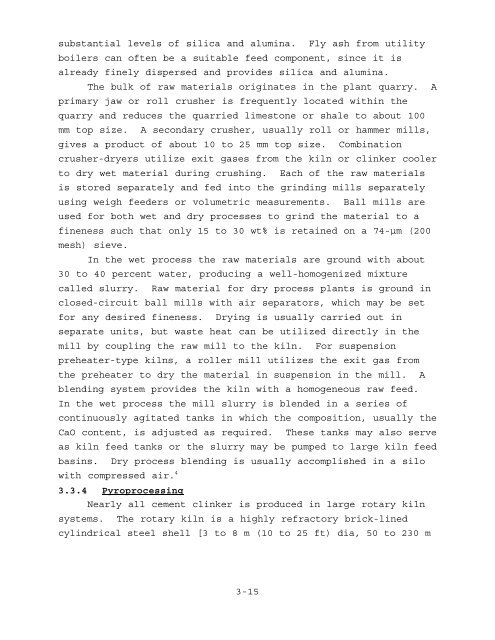NOx Emissions from Cement Mfg - US Environmental Protection ...
NOx Emissions from Cement Mfg - US Environmental Protection ...
NOx Emissions from Cement Mfg - US Environmental Protection ...
You also want an ePaper? Increase the reach of your titles
YUMPU automatically turns print PDFs into web optimized ePapers that Google loves.
substantial levels of silica and alumina. Fly ash <strong>from</strong> utility<br />
boilers can often be a suitable feed component, since it is<br />
already finely dispersed and provides silica and alumina.<br />
The bulk of raw materials originates in the plant quarry. A<br />
primary jaw or roll crusher is frequently located within the<br />
quarry and reduces the quarried limestone or shale to about 100<br />
mm top size. A secondary crusher, usually roll or hammer mills,<br />
gives a product of about 10 to 25 mm top size. Combination<br />
crusher-dryers utilize exit gases <strong>from</strong> the kiln or clinker cooler<br />
to dry wet material during crushing. Each of the raw materials<br />
is stored separately and fed into the grinding mills separately<br />
using weigh feeders or volumetric measurements. Ball mills are<br />
used for both wet and dry processes to grind the material to a<br />
fineness such that only 15 to 30 wt% is retained on a 74-µm (200<br />
mesh) sieve.<br />
In the wet process the raw materials are ground with about<br />
30 to 40 percent water, producing a well-homogenized mixture<br />
called slurry. Raw material for dry process plants is ground in<br />
closed-circuit ball mills with air separators, which may be set<br />
for any desired fineness. Drying is usually carried out in<br />
separate units, but waste heat can be utilized directly in the<br />
mill by coupling the raw mill to the kiln. For suspension<br />
preheater-type kilns, a roller mill utilizes the exit gas <strong>from</strong><br />
the preheater to dry the material in suspension in the mill. A<br />
blending system provides the kiln with a homogeneous raw feed.<br />
In the wet process the mill slurry is blended in a series of<br />
continuously agitated tanks in which the composition, usually the<br />
CaO content, is adjusted as required. These tanks may also serve<br />
as kiln feed tanks or the slurry may be pumped to large kiln feed<br />
basins. Dry process blending is usually accomplished in a silo<br />
with compressed air. 4<br />
3.3.4 Pyroprocessing<br />
Nearly all cement clinker is produced in large rotary kiln<br />
systems. The rotary kiln is a highly refractory brick-lined<br />
cylindrical steel shell [3 to 8 m (10 to 25 ft) dia, 50 to 230 m<br />
3-15

















